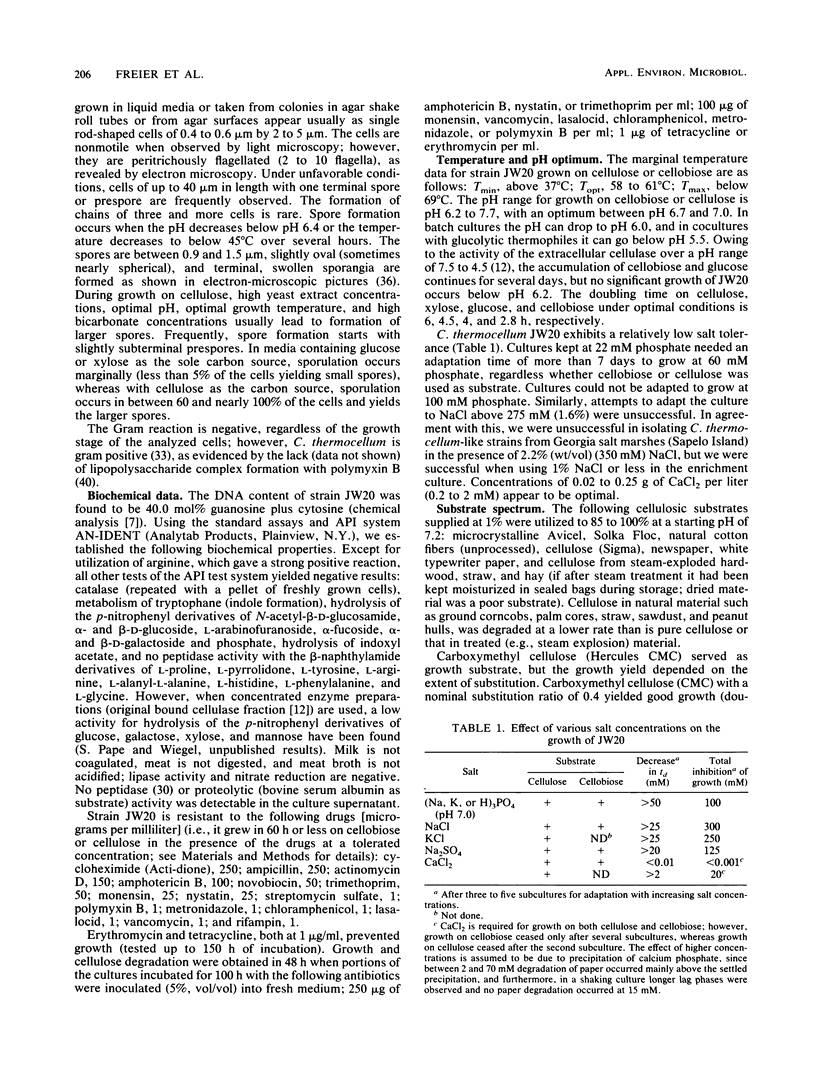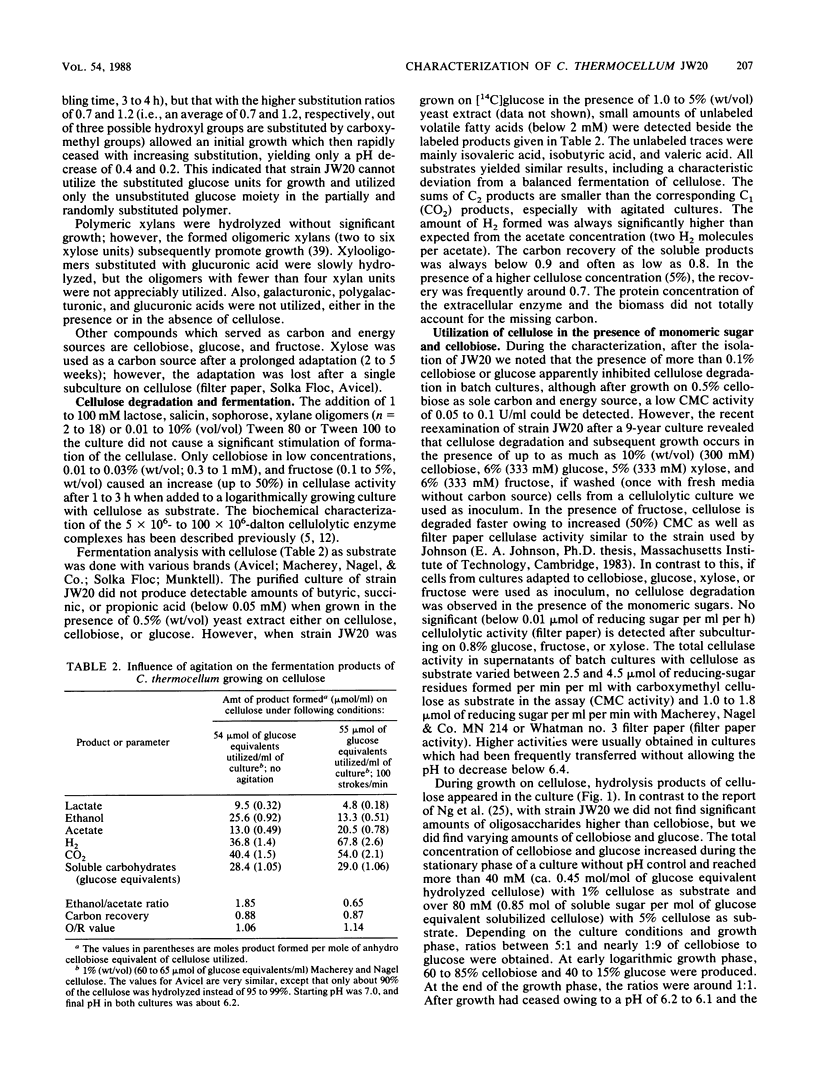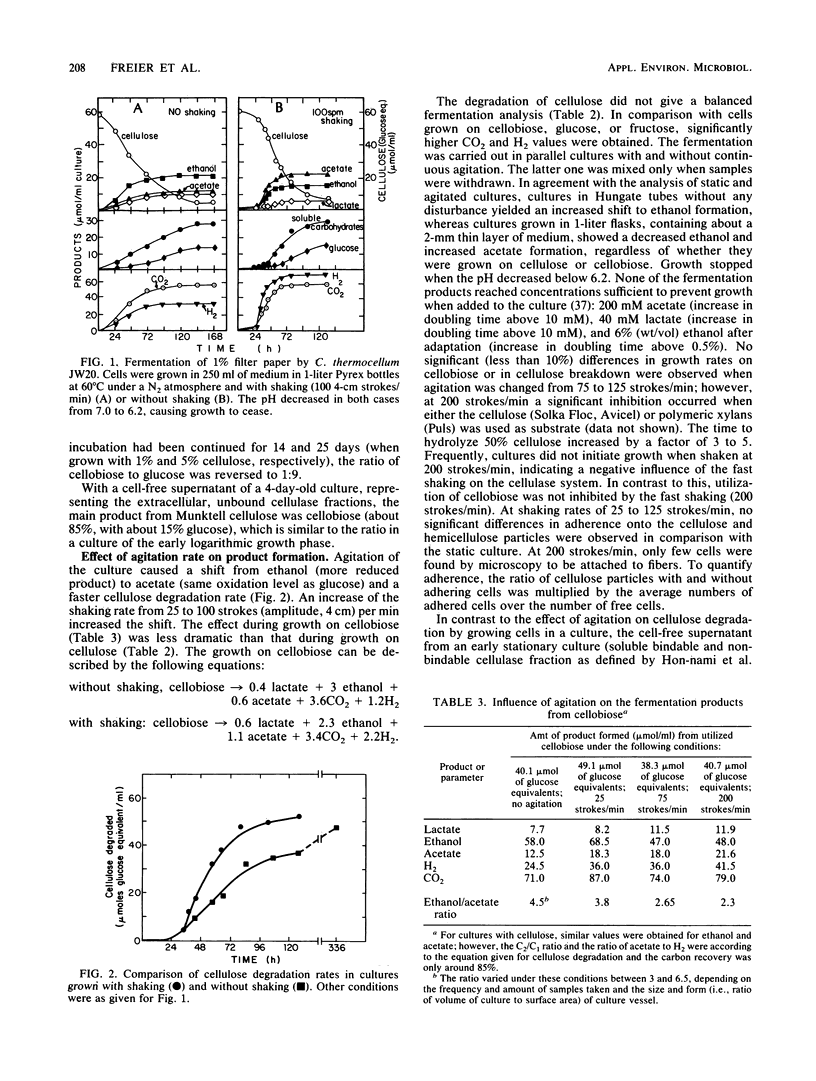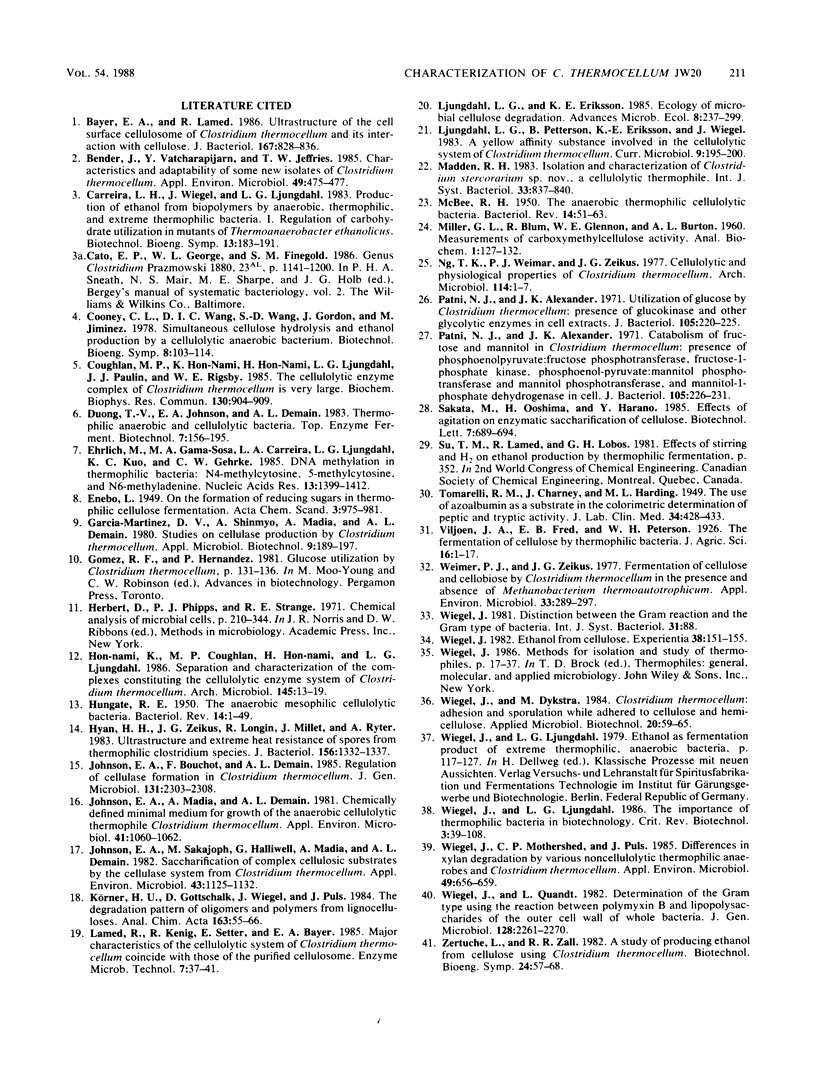Abstract
Clostridium thermocellum JW20 (ATCC 31549), which was isolated from a Louisiana cotton bale, grew on cellulose, cellobiose, and xylooligomers and, after adaptation, on glucose, fructose, and xylose in the pH range of 7.5 to 6.1 with Topt of 60°C, Tmax of 69°C, and Tmin of above 28°C. Doubling times during growth on cellulose and cellobiose were 6.5 and 2.5 h, respectively. The G+C content of the DNA was 40 mol% (chemical analysis). Growth on cellulose as substrate was totally inhibited in the presence of more than 125 mM sodium sulfate, 300 mM sodium chloride, 250 mM potassium chloride, 200 mM calcium chloride, 125 mM magnesium chloride, 40 mM lactate, or 250 mM acetate. The ratio of the fermentation products ethanol to acetate plus H2 decreased when the culture was agitated. Agitation otherwise increased the rate of cellulose degradation in a growing culture but not under nongrowth conditions or with cell-free culture supernatant containing the extracellular cellulase. Shaking lowered the concentration of H2 in the culture broth and thus minimized inhibition by the H2 formed. Externally added H2 caused an increased formation of ethanol during growth on cellulose or cellobiose. However, at an atmospheric pressure as high as 355 kPa (50 lb/in2), H2 did not cause significant growth inhibition beyond an increasing lag phase (up to 24 h). Several criteria to specifically prove the purity of C. thermocellum cultures were suggested.
Full text
PDF







Selected References
These references are in PubMed. This may not be the complete list of references from this article.
- Bayer E. A., Lamed R. Ultrastructure of the cell surface cellulosome of Clostridium thermocellum and its interaction with cellulose. J Bacteriol. 1986 Sep;167(3):828–836. doi: 10.1128/jb.167.3.828-836.1986. [DOI] [PMC free article] [PubMed] [Google Scholar]
- Bender J., Vatcharapijarn Y., Jeffries T. W. Characteristics and Adaptability of Some New Isolates of Clostridium thermocellum. Appl Environ Microbiol. 1985 Mar;49(3):475–477. doi: 10.1128/aem.49.3.475-477.1985. [DOI] [PMC free article] [PubMed] [Google Scholar]
- Coughlan M. P., Hon-Nami K., Hon-Nami H., Ljungdahl L. G., Paulin J. J., Rigsby W. E. The cellulolytic enzyme complex of Clostridium thermocellum is very large. Biochem Biophys Res Commun. 1985 Jul 31;130(2):904–909. doi: 10.1016/0006-291x(85)90502-9. [DOI] [PubMed] [Google Scholar]
- Ehrlich M., Gama-Sosa M. A., Carreira L. H., Ljungdahl L. G., Kuo K. C., Gehrke C. W. DNA methylation in thermophilic bacteria: N4-methylcytosine, 5-methylcytosine, and N6-methyladenine. Nucleic Acids Res. 1985 Feb 25;13(4):1399–1412. doi: 10.1093/nar/13.4.1399. [DOI] [PMC free article] [PubMed] [Google Scholar]
- HUNGATE R. E. The anaerobic mesophilic cellulolytic bacteria. Bacteriol Rev. 1950 Mar;14(1):1–49. doi: 10.1128/br.14.1.1-49.1950. [DOI] [PMC free article] [PubMed] [Google Scholar]
- Hyun H. H., Zeikus J. G., Longin R., Millet J., Ryter A. Ultrastructure and extreme heat resistance of spores from thermophilic Clostridium species. J Bacteriol. 1983 Dec;156(3):1332–1337. doi: 10.1128/jb.156.3.1332-1337.1983. [DOI] [PMC free article] [PubMed] [Google Scholar]
- Johnson E. A., Madia A., Demain A. L. Chemically Defined Minimal Medium for Growth of the Anaerobic Cellulolytic Thermophile Clostridium thermocellum. Appl Environ Microbiol. 1981 Apr;41(4):1060–1062. doi: 10.1128/aem.41.4.1060-1062.1981. [DOI] [PMC free article] [PubMed] [Google Scholar]
- Johnson E. A., Sakajoh M., Halliwell G., Madia A., Demain A. L. Saccharification of Complex Cellulosic Substrates by the Cellulase System from Clostridium thermocellum. Appl Environ Microbiol. 1982 May;43(5):1125–1132. doi: 10.1128/aem.43.5.1125-1132.1982. [DOI] [PMC free article] [PubMed] [Google Scholar]
- McBEE R. H. The anaerobic thermophilic cellulolytic bacteria. Bacteriol Rev. 1950 Mar;14(1):51–63. doi: 10.1128/br.14.1.51-63.1950. [DOI] [PMC free article] [PubMed] [Google Scholar]
- Moreno J. D., Bayer R. The limits of the ledger in public health promotion. Hastings Cent Rep. 1985 Dec;15(6):37–41. [PubMed] [Google Scholar]
- Ng T. K., Weimer T. K., Zeikus J. G. Cellulolytic and physiological properties of Clostridium thermocellum. Arch Microbiol. 1977 Jul 26;114(1):1–7. doi: 10.1007/BF00429622. [DOI] [PubMed] [Google Scholar]
- Patni N. J., Alexander J. K. Catabolism of fructose and mannitol in Clostridium thermocellum: presence of phosphoenolpyruvate: fructose phosphotransferase, fructose 1-phosphate kinase, phosphoenolpyruvate: mannitol phosphotransferase, and mannitol 1-phosphate dehydrogenase in cell extracts. J Bacteriol. 1971 Jan;105(1):226–231. doi: 10.1128/jb.105.1.226-231.1971. [DOI] [PMC free article] [PubMed] [Google Scholar]
- Patni N. J., Alexander J. K. Utilization of glucose by Clostridium thermocellum: presence of glucokinase and other glycolytic enzymes in cell extracts. J Bacteriol. 1971 Jan;105(1):220–225. doi: 10.1128/jb.105.1.220-225.1971. [DOI] [PMC free article] [PubMed] [Google Scholar]
- Weimer P. J., Zeikus J. G. Fermentation of cellulose and cellobiose by Clostridium thermocellum in the absence of Methanobacterium thermoautotrophicum. Appl Environ Microbiol. 1977 Feb;33(2):289–297. doi: 10.1128/aem.33.2.289-297.1977. [DOI] [PMC free article] [PubMed] [Google Scholar]
- Wiegel J., Mothershed C. P., Puls J. Differences in Xylan Degradation by Various Noncellulolytic Thermophilic Anaerobes and Clostridium thermocellum. Appl Environ Microbiol. 1985 Mar;49(3):656–659. doi: 10.1128/aem.49.3.656-659.1985. [DOI] [PMC free article] [PubMed] [Google Scholar]
- Wiegel J., Quandt L. Determination of the gram type using the reaction between polymyxin B and lipopolysaccharides of the outer cell wall of whole bacteria. J Gen Microbiol. 1982 Oct;128(10):2261–2270. doi: 10.1099/00221287-128-10-2261. [DOI] [PubMed] [Google Scholar]


